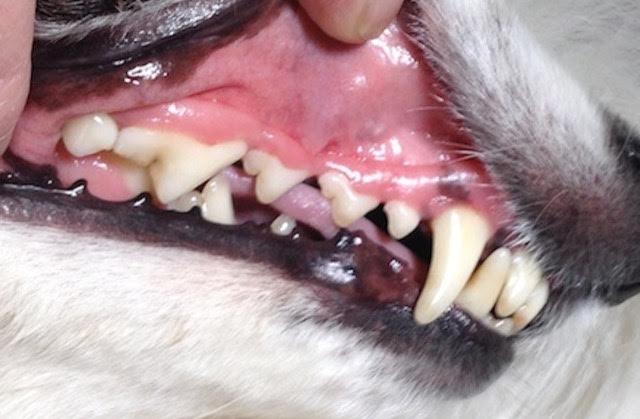![]()
True, some dogs do have teeth pulled. It’s unavoidable for many, since bad teeth can adversely affect overall health and even behavior. But regular doggy dental care at home doesn’t have to be a battle, not if you approach it with patience and a positive attitude.
Start with your puppy the day she comes home.
Ask your veterinarian at your initial well-puppy visit to show you how to handle your puppy’s mouth and teeth gently and easily. Find out what to expect in your pup’s dental development over her first year of life. When will those tiny puppy teeth fall out, when will adult teeth replace them? What will the puppy experience during the process of teething and later, as the teeth fully seat within her jaws?
Add regular gentle touching of your puppy’s lips, teeth, and gums to your grooming regimen, using tricks you’ll learn in puppy classes to help your pup develop good bite inhibition (teaching your puppy in a very positive manner never to bite down on human skin or clothing).
Start with your adult dog after a dental exam.
Ask your veterinarian to assess the need for a full dental cleaning and any extractions, with the goal of a clean slate on which you can start regular at-home dental care, regardless of the dog’s age.
Don’t assume your “new” adult dog will accept even gentle handling of his mouth or teeth. Get some direction on introducing “mouth handling” to a newly adopted dog from your pet dog class instructor, or consult a force-free, positive, ethical trainer to work with you on that and other new skills.
You simply cannot “punish” a dog for not allowing you to handle his mouth. You have to change his mind about how rewarding that can be!


Photo by Debi Davis
I asked dog lovers and dog professionals about their doggy dental-care regimens.
Debi Davis (Nevada) If your dog has not had a dental cleaning recently and you see any signs of swelling on the gum tissue, bleeding, plaque accumulation, or foul breath, then your dog needs a professional cleaning under anesthesia before you start a brushing routine. Without a thorough scaling to remove the hardened plaque (calculus), and polishing so that new plaque finds it harder to form, brushing will be painful to the dog, and could cause the dog undue stress over a daily procedure that should be painless and pleasant.
Donna Wilson Wolff (Illinois) After having 16 teeth pulled, my 15-year-old rat terrier fights having her teeth brushed. I now keep brush and paste on the sofa table and, when she comes near, I offer her a brush with beef-flavored paste to lick.
Jill Gibbs (Montana) I have my dogs up on the grooming table so there is no escape. I started with letting them lick the poultry toothpaste off the toothbrush. They all love it so I start with their front teeth.
Jules Weber (Maryland): My pets love having their teeth brushed. I shaped it. I have a really old video that’s terrible quality if you want to see how I do it.
Doggie Dental—Teaching Pets Toothbrushing/Grooming
Micha Michlewicz (Maryland) I’ve used many gels and pastes, and I think that the ones with chlorhexidine and zinc, or some of the enzymatic ones, are the best. The enzymatic ones are at least a good place to start because they’re meaty and are usually accepted pretty well.
I start in baby steps, bit by bit and adding onto the duration and intensity of brushing, always using treats (or a training toy) to pair as a reward.
I like dental brushes that have three brushing surfaces, to get all the sides of the teeth. But it’s easier to start them on a simple one-sided brush on the outside surface of their teeth. My preference is a Sonic brush, as it makes a huge difference, but that can take a lot of work for some dogs to accept, while others will accept it very readily.
I brush at least once a day, before I brush mine at night, because it’s the easiest to remember.
Kim Campbell Thornton (California) I’m kind of tempted to get them their own Waterpik. It just seems like they would be more willing to accept that than actually having the teeth brushed with a powered toothbrush. And for dogs that eat canned or raw food—or home-cooked—it might help keep food from sticking to teeth or getting caught in flews and stinking up the mouth.
Debi Davis (Nevada) Consider that you’ve just cleaned your dog’s teeth, gotten the stuck food out from under the gum line, and then you give them a treat? Why not use a tiny squeeze of the toothpaste itself instead as a reward? 1/8 to 1/4 of a line of toothpaste they can lick off the tube is a great treat, and it’s not adding more food that will start the plaque forming again. This was what one dental veterinarian suggested to me instead of a food treat after the regimen.
Summer Storm Kingery DVM (North Carolina) I like dental wipes wrapped around a finger. I use one to scrub the teeth, then follow up with a lickable treat like peanut butter or chicken broth. There are some flavored dental wipes, but Vetradent are my favorite. It’s the friction on the surface of the tooth that matters. [After the cleaning], I don’t think liquid or gel-type rewards that are licked do much to [leave debris on the teeth]. I wouldn’t do dog biscuits where debris could wind up on the teeth again. Stick to things without carbs, like broths. I just find that dogs seem to be less stressed by fingers—being careful, of course. No one should be damaged.
Veterinarians and veterinary clinics may offer special discounts on dental procedures during National Pet Dental Health Month, which just happens to be THIS month: February!
National Pet Dental Health Month (American Veterinary Medical Association)
https://www.avma.org/events/national-pet-dental-health-month



